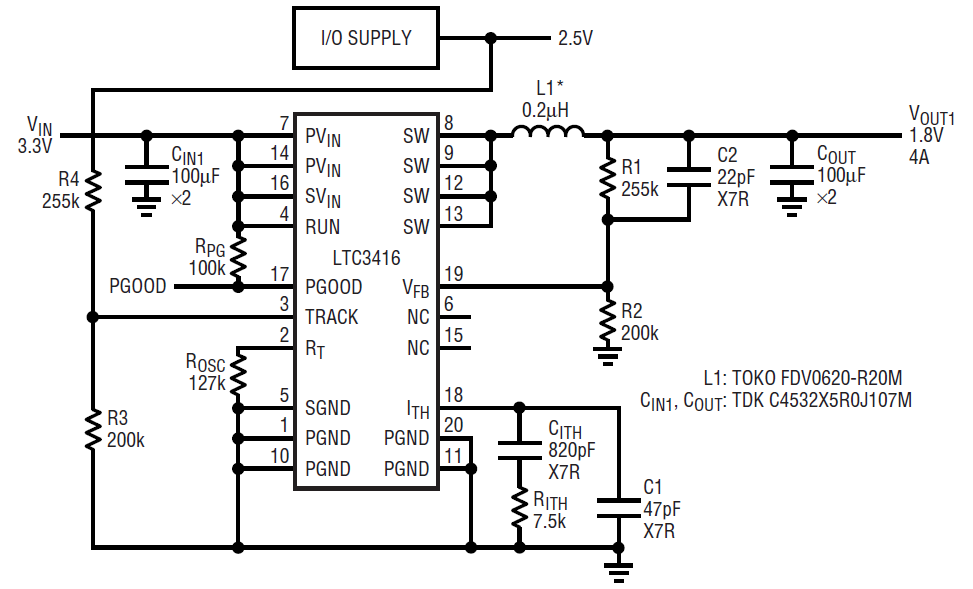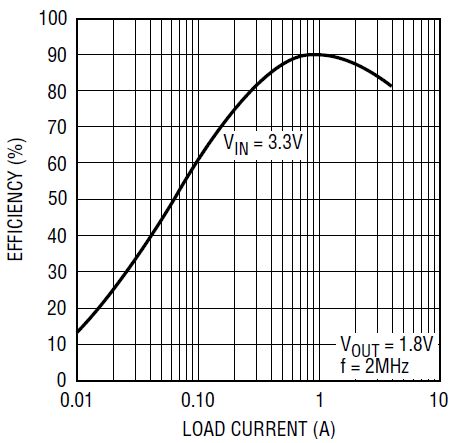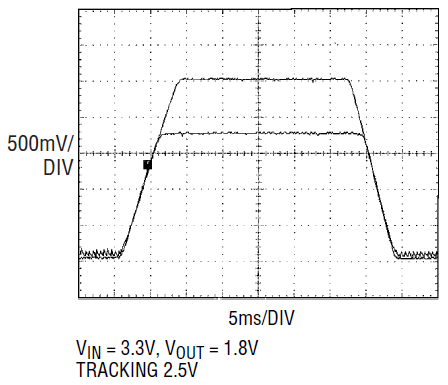4A, 4MHz Monolithic Synchronous Regulator with Tracking offers a Compact Solution for Power Supply Sequencing
4A, 4MHz Monolithic Synchronous Regulator with Tracking Offers a Compact Solution for Power Supply Sequencing
by
Joey Esteves
May 1 2004
Introduction
The LTC3416 offers a compact and efficient voltage regulator solution for systems that require power supply sequencing between different supply voltages. Many microprocessors and DSP chips need a core power supply and an I/O power supply that must be sequenced during start-up. Without proper power supply sequencing, latch-up or excessive current draw may occur that could lead to damage to the microprocessor’s I/O ports or the I/O ports of a supporting device such as memory, logic, FPGAs, or data converters. The LTC3416 operates from an input voltage range of 2.25V to 5.5V and can generate an output voltage between 0.8V to 5V. The internal power MOSFET switches have a low 67mΩ on-resistance, thus allowing the LTC3416 to deliver up to 4A of output current while achieving efficiencies as high as 91%.
The LTC3416 employs a constant frequency, current-mode architecture with a frequency range of 300KHz to 4MHz. Forced continuous operation allows the LTC3416 to maintain a constant frequency throughout the entire load range, making it easier to filter the switching noise and reduce the RF interference—important for EMI-sensitive applications.
The switching frequency can be set externally with a resistor or synchronized to an external clock, where each switching cycle begins at the falling edge of the external clock signal. Since the output voltage ripple is inversely proportional to switching frequency and inductor value, a designer can take advantage of the LTC3416’s high switching frequency to use smaller inductors without compromising the output voltage ripple. Lower inductor values translate directly to smaller case sizes, reducing the overall size of the system. OPTI-LOOP® compensation allows the transient response to be optimized over a wide range of loads and output capacitors, including ceramics. For increased thermal handling, the LTC3416 is offered in a 20-Lead TSSOP package with an exposed pad to facilitate heat sinking.
Voltage tracking is enabled by applying a ramp voltage to the TRACK pin. When the voltage on the TRACK pin is below 0.8V, the feedback voltage regulates to this tracking voltage. When the tracking voltage exceeds 0.8V, tracking is disabled and the feedback voltage regulates to the internal reference voltage. Tracking is implemented by connecting an extra resistor divider to the I/O supply voltage. The ratio of this divider should be selected to be the same as that of the LTC3416’s feedback resistor divider.
1.8V/4A Converter Tracks a 2.5V I/O Supply
Figure 1 shows a 1.8V step-down DC/DC converter tracking an I/O supply voltage of 2.5V. This circuit operates from an input voltage of 3.3V and provides a regulated 1.8V output at up to 4A of load current. Efficiency is as high as 90% and is shown in Figure 2.

Figure 1. A 1.8V/4A step-down regulator with tracking

Figure 2. Efficiency vs load current
The switching frequency for this circuit is set at 2MHz by a single external resistor, ROSC. Operating at a frequency this high allows the use of a lower valued and physically smaller inductor. During start-up, the output of the LTC3416 coincidentally tracks the I/O supply voltage. Once the I/O supply voltage exceeds 1.8V, tracking is disabled and the LTC3416 regulates its output voltage to 1.8V. Figure 3 shows the relationship between the output voltage waveform of the LTC3416 and the I/O supply voltage during start-up.

Figure 3. Start-up and shut-down tracking
Ceramic capacitors offer low cost and low ESR, but many switching regulators have difficulty operating with them because the extremely low ESR can lead to loop instability. The phase margin of the control loop can drop to inadequate levels without the aid of the zero that is normally generated from the higher ESR of tantalum capacitors. The LTC3416, however, includes OPTI-LOOP compensation, which allows it to operate properly with ceramic input and output capacitors. The LTC3416 allows loop stability to be achieved over a wide range of loads and output capacitors with proper selection of the compensation components on the ITH pin.
Conclusion
The LTC3416 with its tracking ability is well suited to applications involving microcontroller-based circuits with dual supply architectures. It’s high switching frequency and internal low RDS(ON) power switches allow the LTC3416 to provide a small solution size with high efficiency for systems with power supply sequencing requirements.




















